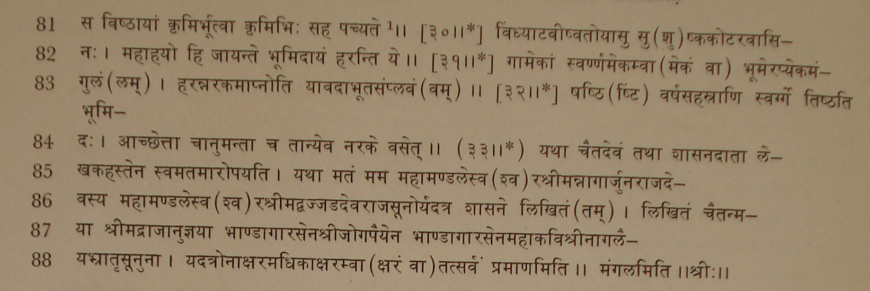|
The Indian Analyst
|
North Indian Inscriptions |
INSCRIPTIONS OF THE SILAHARAS OF NORTH KONKAN
TRANSLATION [For the translation of verses 1-3, 10 and 11, see that of the verses 1, 2 and 4, 8, and 9 in the Ṭhāṇā plates of Arikēsarin (No. 8), and for that verses 4 to 9 see the translation of the same verses in the Berlin Museum plates of Chhittarāja (No.11) above, pp. 68-69.] ..(V. 12). He was Karṇa himself in respect of liberality, Yudhishṭhira in that of truthfulness, the refulgent Sun in that of valour, and was the rod of the god of death to his enemies. .. (V. 13). Victorious is that king, who protected even the feudatories of other (kings) when they sought refuge with him, and who rightly obtained the title of ‘the adamantine cage (given protection) to those who seek it.â .. (V. 14). What else can be described of him who welcomed in various ways Gōmma, who resorted to him (for protection), who caused to be made firm the infirm rule of Aiyapadēva, who gave protection to Bhillama, Ammaṇa and Mambuva, and who was thus (veritable) Rāma among title-holders.
.. (V. 15). From him was born the son named Vajjaḍadēva (II), who was conversant with political wisdom and was a (veritable ) crest-jewel of kings,−whose deeds all people even now praise, with their creeper-like bodies having clothes of horripilation. .. (V. 16). Then there was born his brother, King Arikēsarin, who had the grace of the thunderbolt in destroying the principal mountains in the form of arrogant foes; who, even when he was a boy, went with an army to Sōmēśvara and having seen (that god ), came back after offering him the whole world by the order of his father. .. (V. 17). (Thereafter) his brother’s son the illustrious Chhittarāja became king, who, noble as he was, raised Silara family to great eminence, though he was (then) only in his boyhood. .. ( V. 18). The creeper of his fame rises up to the maṇḍapa of the Brahmāṇḍa, being as it were fostered by the tears from the eyes of the wives of the enemies killed by him. .. (V. 19). Then his younger brother Nāgārjuna become king− (he) whose wrath was the fire of destruction to his arrogant foes, and who was Nārāyaṇa in respect of good nature while dealing with courtesans. Having heard from afar about his superhuman and great might of arms, the itching of his enemies, fond of the field of battle, goes to sleep as it were.
..
(V. 20). The quarter-elephants, the streams of whose ichor dry up on the spread of
the breezes blowing over the rut of the intoxicated scent-elephants in his unique camp, open
their eyes (after a long time )− (the eyes) which had been closed through fear when the enormous
smoke springing from the conflagration of his enemies’ cities spread in the quarters. [1] Metre of verses 30-33 : Anushṭubh.
|
|||||||||||||||||||||||||||||||||||||||||||||||||||||||||||||||||||||||||||||||||||||||||||||||||||||||||||||||||||||
| > |
|
>
|








